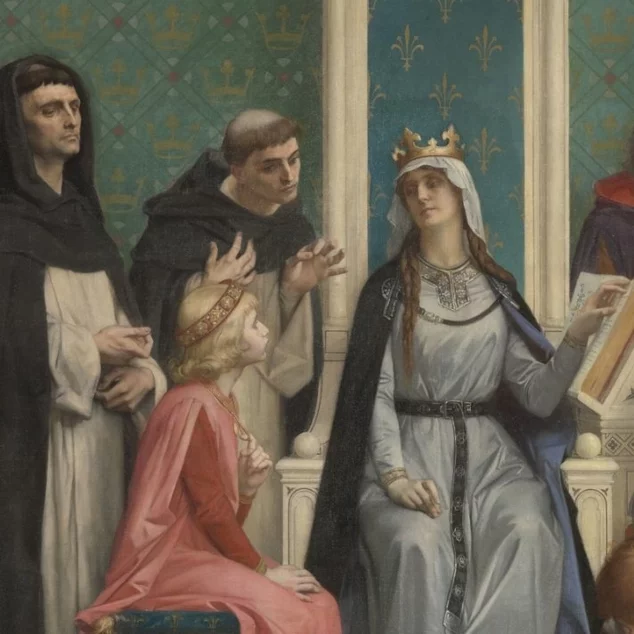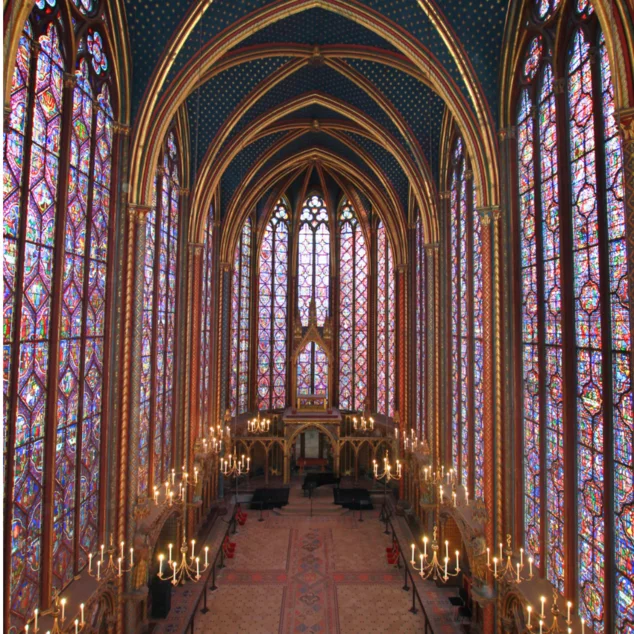History
article | Reading time5 min
History
article | Reading time5 min
Discover the history of this jewel of High Gothic architecture located in the heart of historical Paris on the Ile de la Cité!
Precious vestige of the royal palace of the CityThe Sainte-Chapelle was built in the middle of the 13th century by Louis IX, future Saint Louis, to house the most prestigious relic of the Passion of Christ: the Crown of Thorns and a fragment of the True Cross.
Built in less than 7 years, a record time, the Sainte-Chapelle was conceived as a piece of goldsmith's art, whose walls of light exalt the Capetian monarchy and the kingdom of France.
Damaged during the Revolution, the former palatine chapel became a laboratory for the restoration of historical monuments in the 19th century. Divided into 15 stained glass bays of 15m height, the 1113 stained glass panels of the windows relate scenes of the Old and New Testament and tell the history of the world, according to the Bible, until the arrival of the relics in Paris in the 13th century.
Benjamin Gavaudo - Centre des monuments nationaux
Key historical figure, Louis IX, known as "the Prudhomme" and more commonly called Saint Louis was a Capetian king of France born on 25th April 1214 in Poissy and died on 25th August 1270 in Carthage, near Tunis. He reigned for over 43 years, from 1226 until his death.
Louis IX was considered a saint during his lifetime and was canonized by the Catholic Church in 1297.
He inherited the crown upon the death of his father, King Louis VIII, when he was only twelve years old. It is Blanche of Castile, his mother, from whom he receives a strict and pious education, who ensures the regency until his majority.
If we do not know precisely the master builder of the Sainte-Chapelle, there is no doubt that its patron, Saint Louis, played a considerable role in the conception of this building, conceived as a giant reliquary exalting the relics of the Passion and the political power of the monarch.
© Romaric Pech - Centre des monuments nationaux
In medieval times, Christian fervor attributed great value to relics, whose possession conferred considerable prestige.
In 1239, after two years of negotiation, Louis IX acquired the Crown of Thorns from Beaudouin II of Courtenay, Latin emperor of Byzantium.
Other relics (22 in total, including a fragment of the True Cross) were acquired in 1241, and Louis IX decided to build a monument worthy of this treasure.
With this extraordinary acquisition, 135,000 livres tournois, or half the annual income of the kingdom, Saint Louis expressed his piety, but also increased the prestige of France.
Paris became, in the eyes of medieval Europe, a "new Jerusalem", and thus the beacon of Western Christianity.
Benjamin Gavaudo - Centre des monuments nationaux
The building was also conceived as a palatine chapel, located in the heart of the residence of the Capetian kings on the Ile de la Cité. It consists of an upper level, the upper chapel in which the relics of the Passion of Christ are exalted and reserved for the king and his distinguished guests, and a lower chapel serving the palace staff. The upper chapel was directly connected to the king's apartments by a gallery ("la galerie Mercière", named after the numerous shops that were located there).
The tribune of the relics, installed in the 1260s and reconstituted during the 19th century restoration, supported the large silver and gilded copper shrine that held the holy relics. The shrine and the reliquaries (casket, intended to contain one or more relics) were melted down during the Revolution and most of the relics have disappeared. The crown of thorns, however, was preserved and joined the treasury of Notre-Dame Cathedral in 1806.
Although the reliquary function of the monument has disappeared (the Sainte-Chapelle is no longer used for worship since the Revolution), the monument still shines today as one of the most extraordinary masterpieces of the High Gothic style.
You will undoubtedly be struck during your visit by the extreme architectural lightness of the upper chapel and its 670 m2 of stained glass windows that envelop you in an extraordinary and intense light. Conceived as a single vessel of four bays ending in a seven-sided chevet, its reliquary shape gives it a striking verticality and an incomparable brilliance.
The robust and powerful architecture of the lower chapel serves as a support for the upper chapel and its immense stained glass windows. Thus freed from the stone, the walls seem to have disappeared in favor of immense stained glass windows whose elegance has always been admired.
You will also be able to contemplate the spire, a feat reconstituted in the 19th century and as inescapable in the Parisian panorama as that of the Notre-Dame cathedral. It is the fifth spire since the original contruction and it rises to seventy-five meters above the ground.
Patrick Cadet - Centre des monuments nationaux
Immerse yourself in this vessel of light and admire the exceptional set of stained glass windows that constitute the most complete example of 13th century stained glass art. Indeed, two-thirds of the windows are original. The flamboyant style rose window is an extraordinary testimony of the 15th century.
Let yourself be dazzled by 15 exceptional stained glass windows of breathtaking dimensions (15m high in the nave and 13m in the choir!). The windows are composed of 1113 scenes of the Old and the New Testament telling the history of the world, according to the Bible, until the arrival of the relics in Paris then the Apocalypse is represented in the rose window.
Pascal Lemaître - Centre des monuments nationaux
The upper chapel is adorned with a sculpted decoration remarkable for its finesse and variety. More than a hundred different plant motifs animate the columns, while the twelve statues of apostles illustrate two styles of 13th century Parisian sculpture.
In the lower chapel, admire the 140 capitals representing the nuances of the elegant Gothic flora, as well as the small interior buttresses, the "étrésillons" which distribute the thrust of the vaults.
DR - Centre des monuments nationaux
Damaged by fires in 1630 and 1776, then during the Revolution, the building was used as a flour warehouse, then was transformed into an archive depository from 1803 to 1838 for the needs of the maw courts. Soùe of the windows were then walled up, and the stained glass panels were either destroyed or dismantled, and some were then dispersed on the art market, notably in England.
Thanks to the pressure of public opinion and great defenders such as Victor Hugo, the Sainte-Chapelle was saved from destruction. It was the subject of a vast and exemplary restoration project between 1840 and 1863, carried out successively by the architects Duban, Lassus and Boeswillwald, who endeavored to restore it to its 13th century appearance. This model site served as a laboratory for the restoration and conservation of historical monuments.
© Bibliothèque nationale de France
History, Art & Architecture
video | 2 min










